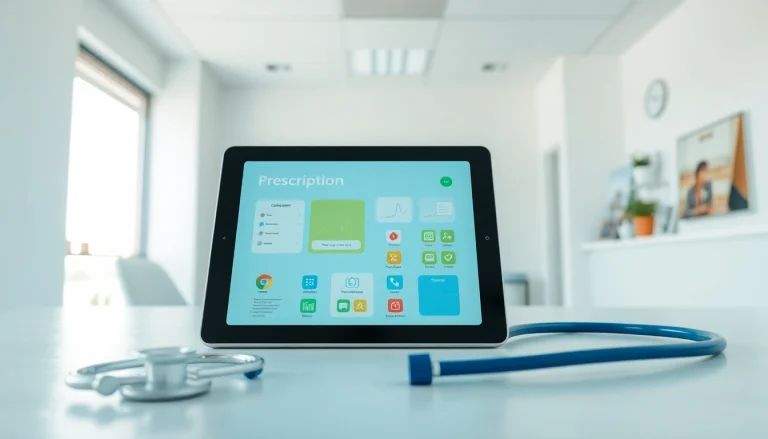
Understanding E-Prescribing Software: A Comprehensive Overview
E-prescribing software has revolutionized the way healthcare providers issue and manage prescriptions. As the healthcare industry increasingly embraces technology, the demand for efficient and secure solutions has never been higher. Among the various available technologies, eprescribing software reviews play a critical role in guiding healthcare organizations toward the most suitable options.
What Is E-Prescribing Software?
E-prescribing software is a digital tool that enables healthcare providers to write and send prescriptions to pharmacies electronically. This technology replaces the traditional paper-based systems, significantly reducing errors associated with handwritten prescriptions, such as illegible handwriting or misunderstandings regarding dosage. The core function of e-prescribing solutions is to facilitate secure, streamlined communication between prescribers, patients, and pharmacies, ensuring that medications are dispensed accurately and on time.
Key Features and Functionalities
Modern e-prescribing solutions come with a variety of features designed to enhance usability and safety for both practitioners and patients. Here are some critical functionalities:
- Prescription Management: Efficient management of patient prescriptions, including dosage, quantity, and refills.
- Drug Interaction Checks: Automatic alerts for potential adverse drug interactions or allergies related to prescribed medications.
- Patient Medication History: Access to a patient’s medication history to inform prescribing decisions.
- Refill Requests: Enabling patients to request refills easily online, streamlining the process.
- Integration with EHR Systems: Seamless integration with Electronic Health Record (EHR) systems for improved overall workflow.
Benefits of Implementing E-Prescribing Solutions
Implementing e-prescribing software can provide numerous benefits for healthcare providers, including:
- Increased Efficiency: E-prescribing leads to faster prescription processing and reduced waiting times for patients.
- Improved Accuracy: Reduction of prescription errors due to illegibility or misinterpretation.
- Enhanced Patient Safety: Automated checks for drug interactions help prevent adverse drug events.
- Cost-Effectiveness: Streamlined operations can lead to reduced administrative burdens and lower operational costs.
- Regulatory Compliance: Helps practitioners comply with federal and state regulations by facilitating secure prescribing practices.
Evaluating E-Prescribing Software Reviews: Criteria for Assessment
With numerous e-prescribing software solutions available on the market, evaluating eprescribing software reviews is an essential part of the purchasing decision. Understanding what to consider can help healthcare organizations make informed choices.
What to Look for in Software Reviews
When reading software reviews, it is crucial to focus on certain criteria that give insights into the software’s effectiveness and reliability:
- User Ratings: Pay attention to the overall star ratings, which can indicate general satisfaction among users.
- Feature Set: Look for mentions of features that align with your organization’s specific needs, such as e-prescribing for controlled substances or formulary checks.
- Ease of Use: Read comments on the software’s user interface and user experience, as this impacts workflow efficiency.
- Customer Support: Evaluate user feedback on the quality and responsiveness of support provided by the software vendor.
- Integration Capabilities: Consider reviews that discuss how well the software integrates with existing systems, such as EHRs.
Common Ratings and Criteria Explained
Most review platforms employ a range of ratings and criteria for assessing e-prescribing software. Some common categories include:
- Functionality: The breadth of features offered by the software and how well these meet users’ needs.
- Reliability: The system’s uptime and stability, indicating how consistently the software functions.
- Value for Money: Assessment of software pricing relative to its features and performance.
- Implementation Experience: Experiences from users regarding the onboarding process and the time taken to fully implement the software.
- Security: Evaluation of the software’s security features to protect patient data and ensure compliance with regulations.
User Experience Insights from Reviews
User experiences can provide valuable context for understanding a software’s strengths and weaknesses. Factors to consider include:
- Real-World Feedback: Case studies or testimonials can provide insights on how well the software performs under varied conditions.
- Diverse User Perspectives: Reviews from practitioners in different specialties can reveal specific advantages or disadvantages relevant to their field.
- Long-Term Usage: Look for comments regarding the software’s performance over time, including any issues encountered post-implementation.
Top E-Prescribing Software Reviews: Current Market Leaders
Staying informed about the best-performing software options in the market can significantly impact a healthcare provider’s choice. Analyzing eprescribing software reviews helps identify the current market leaders based on the latest features and user preferences.
Latest Trends and Preferences in E-Prescribing Options
The e-prescribing landscape is constantly evolving, with new technologies and preferences surfacing. Some recent trends include:
- Mobile Accessibility: An increasing number of solutions offer mobile apps, allowing providers to prescribe on-the-go.
- Telehealth Integration: Integration with telehealth platforms, enabling prescriptions during virtual visits.
- Patient Engagement Tools: Features that enhance patient communication, such as automated notifications for refill reminders.
- Interoperability: Demand for systems that work seamlessly with various electronic health records, ensuring efficient interoperability across platforms.
Comparative Analysis of Features and Pricing
Developing a comparative analysis of features and pricing can help potential buyers narrow down their options. Key aspects to evaluate include:
- Pricing Structures: Different software may have varied pricing models, including subscription-based, per-prescription fees, or flat rates.
- Available Features: A detailed breakdown of the software features, including patient history reviews and automated alerts for drug interactions.
- Customization Options: Evaluate whether the software allows customization, enabling providers to tailor the solution to their specific workflows.
- Renewal Fees: Consider any additional costs associated with software updates or support after the first year of use.
User Feedback on Leading Solutions
User feedback plays a pivotal role in understanding the effectiveness of various e-prescribing tools. Points to assess include:
- Positive Aspects: Look for common praises regarding ease of use, the speed of prescription processing, and customer support quality.
- Negative Experiences: Identify recurring complaints, such as software bugs, integration challenges, or lack of specific functionalities.
- Adaptability: How well users adjust to the software over time can indicate a product’s long-term viability.
Implementing E-Prescribing Software: Best Practices for Healthcare Providers
Successfully integrating e-prescribing software into medical practices requires careful planning and execution. Following best practices can facilitate a smoother transition.eprescribing software reviews becomes a guiding tool during the implementation process.
Steps to Successfully Integrate Software into Practice
The integration process can be quite complex and requires several sequential steps to ensure effectiveness:
- Define Objectives: Clearly outline the goals you aim to achieve with the new software, including efficiency and patient safety improvements.
- Select a Suitable Vendor: Choose an e-prescribing solution that aligns with your practice’s size, type, and workflow requirements.
- Plan the Rollout: Develop a detailed implementation plan that includes timelines, responsibilities, and necessary resources.
- Conduct Testing: Before full-scale rollout, perform thorough testing to identify and resolve potential issues.
- Feedback and Adjustments: Collect feedback from users during the initial rollout, adjusting the approach as necessary to improve user experience.
Training Staff and Enhancing User Adoption
Training is a critical element in the successful adoption of new software. Strategies should include:
- Comprehensive Training Sessions: Organize hands-on training for all relevant staff, ensuring they understand the software’s functionalities.
- Easy Access to Resources: Provide user manuals or online resources that staff can reference as they familiarize themselves with the system.
- Ongoing Support: Establish a support system for users to voice concerns or ask questions as they begin using the software.
Monitoring Performance and Optimization Techniques
Once implemented, continuous monitoring of the e-prescribing system is essential. Areas to focus on include:
- User Feedback: Regularly check in with users to gain insight into their experiences and any issues they may be encountering.
- Performance Metrics: Monitor key performance indicators, such as prescription processing times and error rates, to assess the system’s effectiveness.
- Software Updates: Stay up-to-date with software updates or improvements that can enhance functionality and user experience.
Future of E-Prescribing: Trends and Innovations on the Horizon
Emerging Technologies in E-Prescribing
The future of e-prescribing is likely to be shaped by various technological advancements, including:
- Artificial Intelligence: AI could streamline prescription processes, providing smart recommendations for dosages and medication choices based on patient history.
- Blockchain Technology: This could enhance the security and transparency of prescription data, ensuring patient information is kept confidential and safeguarded.
- Telemedicine Integration: As telehealth continues to rise, e-prescribing will likely become an integral component, enabling prescriptions during virtual consultations.
Impact of Regulatory Changes on Software Use
Staying compliant with regulations is crucial for any healthcare provider. Here are potential changes and their impacts:
- Increased Security Requirements: New regulations may necessitate enhanced security measures for patient data protection.
- Auditing Standards: More stringent auditing processes may require e-prescribing software to have robust tracking and reporting capabilities.
- Integration with State Prescription Monitoring Programs: Software may need to incorporate state regulations regarding controlled substances monitoring.
Future Needs of Healthcare Providers
Future demand for e-prescribing solutions will likely focus on:
- User-Centric Design: Emphasis on intuitive interfaces that simplify trainings, reducing the learning curve for healthcare providers.
- Interoperability: The need for seamless communication between various healthcare IT systems will continue to drive demand for integrated solutions.
- Data Analytics: Enhanced data analytics capabilities to enable providers to gain insights from prescription data, improving patient outcomes.






